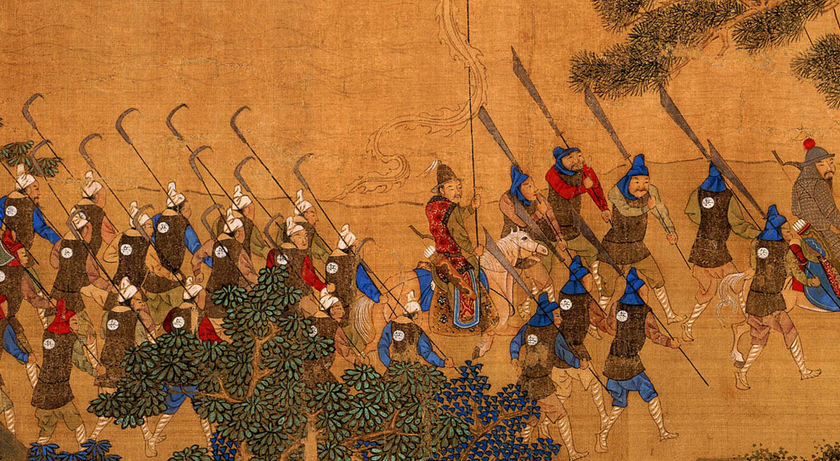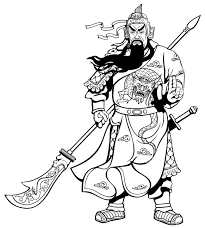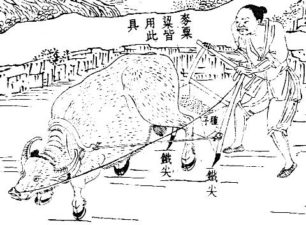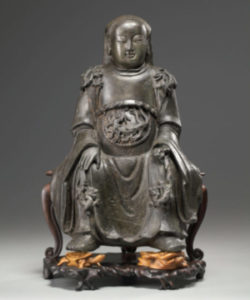Do the origins of Taijiquan matter?
The Answer
Similar to Ralphie in “A Christmas Story” when he imagines the teacher awarding him an A+++ for his well-written essay on why a Daisy Red Ryder BB Gun would be the ultimate gift, I often find myself envisioning that my logically presented discourses on taiji practice will inevitably persuade the reader to agree with my positions. Acknowledging my tendency to bury the lead in explanatory text and realizing that my personal experiential understanding will likely never convince those who wish to believe in the Bodhidharma/Zhang Sanfeng mythology or those who hold onto their lineage with pride or financial interest, I’ll start with the answer to why comprehending the origins of taijiquan holds significance:

Of course the history of taijiquan matters because it is important for me to know that I am in direct lineage to and the recipient of the most authentic and complete teachings so that I know secret things that very few have ever known and that will make me invincible and able to whup ass like Kwai Chang Caine on KungFu did and so I can make major coin and have people revere and adore me as a great and wise teacher by marketing myself as said recipient and holder of the real original art secure in the knowledge that my magnanimous sharing helps people and because that’s a lot better way for me to go than working a hard and thankless job every day.
I trust the reader recognizes facetious merriment, as well as a reference to a 70’s TV series . . .
Jocularity aside, there is one very important lesson in recognizing the origins of taijiquan. By pondering this question, one must first ask “what is taijiquan?” This will inevitably lead one to ponder “what are the internal martial arts and their origins?” And the answer to these questions will help you to understand the essential methods and primary purpose of their original practice. Knowing why is essential to walk a straight path in your practice.
Knowing why is essential to walk a straight path in your practice.
Taijiquan, like all internal martial arts, aims first and foremost to cultivate agility and the proficient utilization of force. Its focus on the efficient use of force and the distinctive physical mechanisms (to the best of my knowledge) for developing and expressing nei jin (内劲, internal power) define the practice of internal martial arts. (Physical mechanisms of internal power, i.e. what internal power is, were detailed in previous blog entries linked below.)
There is a reason for the practice, and that reason was originally to do real work, efficiently, in the real world. Recognizing this very practical objective enables individuals to gain a better understanding of the correct methods of internal arts practice and to distinguish capable taijiquan instructors from others. A direct physical measure of nei dan gongfu (内丹功夫, internal skill) is whether the practitioner can do real work (in the physics sense of moving mass), with power and agility, without quickly tiring. This is the meaning of using four ounces to move 1000 pounds.

Origins of Chinese Martial Arts and How We Came to Know of Taijiquan
Chinese martial arts trace their origins back to their military roots. Historically the vast majority of practitioners acquired their skills through formal military or local militia training and continued to refine their boxing, grappling and weapons expertise in small villages throughout the country, particularly throughout the four northern provinces: Henan (River South), Hebei (River North), Shanxi (Mountain West), and Shandong (Mountain East). While only a tiny minority resided in monasteries, the vast majority of practitioners were hardworking individuals from the working class, often illiterate, whose daily lives revolved around arduous physical labor. Both battlefield survival and enduring routine physical labor demanded physical strength and agility, and the efficient use of force stood out as perhaps the most critical physical skill. Exhaustion from wielding heavy weapons on the battlefield would result in diminished strength, agility, and possibly death. Similarly, performing routine physical labor inefficiently led to a life plagued by injury, pain, and premature mortality. These realities are evident to anyone with extensive experience in combat sports or those who have toiled in physically demanding jobs day after day, year after year.
 |
 |
During the late 19th and early 20th centuries the introduction of promotional yet enigmatic writings, now referred to as “the classics,” both first introduced the name taijiquan and helped to elevate the status of the internal martial arts from a historically perceived low-class or peasant activity to an intellectual and perhaps patriotic or even spiritual pursuit. Wealthy and educated individuals, who were exempt from the necessity of physical labor and combat, became the target market for those instructors who, for the first time in Chinese history, began teaching the art to the public to support their families. Financial constraints compelled them to tailor their branding to appeal to an educated urban audience. As the number of practitioners surged, primarily among those with disposable income and no firsthand experience of relentless physical labor or combat, a significant portion of both students and teachers lacked experiential knowledge of the essential elements of efficient force application and self-nurturing—the core objectives of nei dan gongfu training.
Because form choreography is the only thing that could be branded as a unique commercial product, focus eventually centered mostly on form choreography and opaque and often misunderstood theory. The commercialization and marketing of martial arts (as well as early 20th century efforts to tie martial arts practice to a newly emerging national identity) was a double edged sword. Had taijiquan not become commercialized (or standardized/nationalized by the ruling class) it is likely that most of us would have never heard of it. But the motivations of selling a brand, or of defining martial arts practice within the context of national identity, are very different indeed from passing along a practical martial art to one’s family and clan members.
Competing Takes on Taijiquan History and Why I Don’t Buy Them
Recent new claims to taiji provenance aside, most of us are familiar with the two principal rival factions on taijiquan history: those that, based on the pioneering research of Tang Hao, trace the origin to Chen Wangting (1580-1660) in the Chen village, and those who believe that taiji was created by the mythical Daoist figure Zhang Sanfeng (who, as Douglas Wile notes, is placed variously in the Song, Yuan, and Ming dynasties and biographies of whom, the scholar Anna Seidel adds, “lack even the faintest allusion to his being a boxing master.”) Though accounts on the circumstances differ, even the Yang family admits that Yang Luchan learned (at least in part) in the Chen Village, and Tang Hao’s lineage of the Chen/Yang/Wu family “styles” appears to be irrefutable. But Chen Wanting’s life paralleled that of many martial artists in the four northern provinces throughout Chinese history—he was a commander in the Wen County Garrison and, upon retirement, returned home and continued to refine the martial skills he first obtained in military service. Indeed, as Tang Hao pointed out, many of the Chen village forms include “long range” and “short range” fighting techniques promoted by the famous Ming Dynasty general Qi Jiquang.
It seems to me that claiming that any one person, real or mythical, was responsible for incorporating “Daoist philosophy” into Chinese martial arts at any singular point in time is absurd and, I think, disrespectful of the wisdom of Chinese culture and the greater Chinese martial tradition. The academic historian Tang Hao was, admittedly, likely motivated in part by a desire to refute and remove mythology from the Chinese martial arts—in modern parlance, to keep it real. Hence he concluded that taiji “began” with Chen Wanting, drawing a line at the last person he could identify with reliable historical documents—certainly a fortunate conclusion for the Chen village tourism industry. But the first written reference to yin/yang theory in fighting is found in the Spring and Autumn Annals of Wu and Yue, a first century document which tells the story of King Goujian of Yue (496–465 BCE) and quotes the “Maiden of Yue” claiming the incorporation of yin/yang theory as the reason for her (yes, “her”) exceptional fighting skills. During the Song Dynasty (960-1279) Zhenwu, the “God of War,” was often depicted standing on a tortoise and a snake, which represented the integration of opposing forces (yin and yang) and symbolized his ability to harmonize and balance these forces. Yin/yang theory was associated with martial mastery thousands of years before Chen Wanting.

Further, asserting Daoist origins or a mythical Daoist creator such as Zhang Sanfeng to taijiquan is purposeless since the theory of complementary opposites—yin/yang in Chinese—is a universal philosophical principle and is certainly not exclusive to Daoism. The Greek philosopher Heraclitus observed everything about the interaction of complementary opposites around 500 B.C.; Socrates drew upon the philosophical foundation laid by Heraclitus and based his first argument for the existence of the soul on the interplay of complementary opposites (Phaedo 70-72).
To varying degrees, yin/yang principles are found not only throughout Chinese martial history but in many, if not most, martial arts throughout the world. Attacking where the opponent is weak, and yielding or not struggling against an opponent’s strength, are strategies common to nearly all forms of combat. The MMA fighter Fedor Emiliankano gave some of the best push-hands instructions you will hear in a youtube video of one of his seminars in Russia—you can find a link, transcription and discussion of that in one of my previous blog entries. The great American wrestler Dan Gable has said that the Russians are far more technical than the Americans in their approach to wrestling. Read the transcription of Fedor’s “push-hands 101” grappling instruction in the link above for a perfect example of what he meant.
It is understanding the interaction of yin/yang that is the key to understanding taijiquan theory. Yin and yang are opposite manifestations of the same reality. They are mutually dependent, relative, non-absolute, and in constant flow – the extreme of one is the birth of the other. Yin does not “overcome” yang—balance of yin/yang, and understanding the relationship and flow of yin/yang, is what is sought and what is the foundation of taijiquan theory. All yin, or all yang, are equally wrong and to be avoided. The extreme of softness (as in relaxing in standing meditation) is the birth of extreme yang (greater power through the learned neuromuscular recruitment of core strength). To claim that any lineage or style is “softer” than another is to completely misunderstand yin/yang theory and its application in martial arts. To be “all yin” in the face of an attacker will usually result in the 10 second losses that taiji “masters” seem famous for on Youtube. Understanding yin/yang theory is central to understanding taijiquan and I hope to devote a future blog to it as time allows.
To claim that any lineage or style is “softer” than another is to completely misunderstand yin/yang theory and its application in the internal martial arts.
The development of nei jin (internal power) is the common foundation and purpose of all Chinese internal martial arts. You do not have to know taijiquan forms to obtain nei dan gongfu; you do have to have nei dan gongfu (and understand the practical application of yin/yang theory) to do real taijiquan. Any lineage transmission is merely a miniscule part of the vast history of Chinese martial arts. Everybody is different, and no two masters look the same. Every skilled practitioner possesses unique life experiences and prowess, and was influenced by those who came before them. Chinese martial arts evolved over more than two millennia, and it’s “influenced by” all the way down.
ChatGPT pretty much nailed it:
Me: Based on reliable historical documents, who was the originator of taijiquan?
ChatGPT: . . . In summary, while Zhang Sanfeng is often revered as the originator of Taijiquan based on traditional accounts and legends, the historical evidence to support this claim is limited. The evolution and development of Taijiquan involved multiple influences and contributions from various individuals and martial art styles over time.
😯🤔
I would add “over a very long time” indeed. And, not being the politician that chatGPT is, change “limited” to “nonexistent.”
But how, you may ask, did the skill of efficient movement and power, if rooted in military/martial and rural peasant life, become joined with the concept of self-nurturing and “spiritual” cultivation practices?”
I’ll take that up and provide a little more context on martial and taijiquan history in China, including how a very obvious instance of plagiarism informs us both of the commercial development of taijiquan in the early 20th century and what a Chen village teacher really thought of his art, in Part II.
Previous blog posts describing physical mechanism of nei jin (internal power):
- Entering the door: understanding and training the learned power of the Chinese martial arts—Introduction Part II (August 16, 2022)
- Entering the door: understanding and training the learned power of the Chinese martial arts—Introduction Part I (February 19, 2022)
- More on internal power mechanisms: understanding elastic force (November 29, 2018)
- Physical mechanisms of taiji movement—examining two classical sayings. Part II: intention is primary (May 2, 2018)
- Physical mechanisms of taiji movement—examining two classical sayings. Part I: power is released from the spine. (April 1, 2018)
